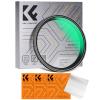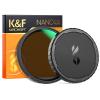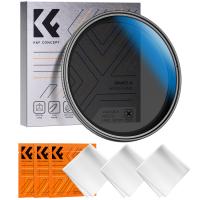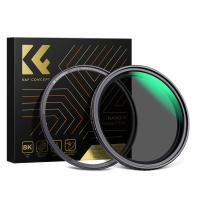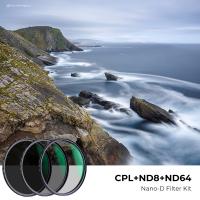What Are The Different Types Of Lens Filters ?
There are several types of lens filters available for photographers, including UV filters, polarizing filters, neutral density filters, color filters, and graduated filters. UV filters are used to reduce the amount of ultraviolet light that enters the lens, which can cause haze and reduce image clarity. Polarizing filters are used to reduce glare and reflections, and can also enhance color saturation and contrast. Neutral density filters are used to reduce the amount of light that enters the lens, allowing for longer exposure times or wider apertures in bright conditions. Color filters are used to alter the color balance of an image, while graduated filters are used to balance the exposure of a scene with a bright sky and darker foreground.
1、 UV filters
What are the different types of lens filters? One of the most common types of lens filters is the UV filter. UV filters are designed to block ultraviolet light, which can cause hazy and blurry images, especially in outdoor photography. They are also useful for protecting the front element of the lens from scratches and other damage.
Other types of lens filters include polarizing filters, which reduce glare and reflections, and neutral density filters, which reduce the amount of light entering the lens without affecting color balance. Graduated neutral density filters are also available, which are useful for balancing the exposure of a scene with bright and dark areas.
In recent years, there has been a growing trend towards using digital filters, which can be applied in post-processing using software such as Adobe Photoshop or Lightroom. These filters can simulate the effects of traditional lens filters, such as polarizers and neutral density filters, and offer greater flexibility and control over the final image.
However, while digital filters can be a useful tool for photographers, they cannot completely replace traditional lens filters. UV filters, for example, still offer valuable protection for the front element of the lens, and polarizing filters can be difficult to replicate digitally, especially in situations where reflections and glare are particularly strong.

2、 Polarizing filters
What are the different types of lens filters? One of the most popular types of lens filters is the polarizing filter. This type of filter is designed to reduce glare and reflections from non-metallic surfaces such as water, glass, and foliage. It can also enhance the color saturation and contrast of the image, making it ideal for landscape and outdoor photography.
Polarizing filters come in two types: circular and linear. Circular polarizing filters are the most commonly used type and are designed to work with autofocus cameras. Linear polarizing filters are less common and are typically used with manual focus cameras.
In recent years, there has been a growing trend towards using digital filters instead of physical ones. Digital filters are software-based and can be applied to images after they have been captured. This approach offers greater flexibility and control over the final image, as well as the ability to experiment with different filter effects without having to invest in physical filters.
However, while digital filters can be a useful tool for post-processing, they cannot replicate the effects of a physical filter in all situations. For example, a polarizing filter can help to reduce glare and reflections in a way that cannot be replicated in post-processing.
Overall, while there are many different types of lens filters available, the polarizing filter remains one of the most popular and effective options for photographers looking to enhance their images.

3、 Neutral density filters
Neutral density filters are one of the most commonly used lens filters in photography. They are designed to reduce the amount of light that enters the camera lens without affecting the color or contrast of the image. This allows photographers to use slower shutter speeds or wider apertures in bright conditions, which can create unique and creative effects.
There are several different types of neutral density filters available, each with its own unique characteristics and uses. Some of the most common types include:
1. Solid neutral density filters: These filters are the most basic type of ND filter and are designed to reduce the amount of light entering the lens by a fixed amount. They are available in different strengths, typically measured in stops, such as 1-stop, 2-stop, or 3-stop filters.
2. Graduated neutral density filters: These filters are designed to reduce the amount of light entering the lens in a graduated manner, with the top of the filter being darker than the bottom. They are often used in landscape photography to balance the exposure between the bright sky and darker foreground.
3. Variable neutral density filters: These filters allow photographers to adjust the amount of light reduction by rotating the filter. They are particularly useful in situations where the lighting conditions are constantly changing, such as during a sunset or sunrise.
In recent years, there has been a growing trend towards using digital filters instead of physical filters. These digital filters can be applied in post-processing using software such as Adobe Photoshop or Lightroom, allowing photographers to achieve similar effects without the need for physical filters. However, many photographers still prefer to use physical filters as they can provide a more accurate and predictable result.

4、 Graduated filters
What are the different types of lens filters? One of the types of lens filters is the graduated filter. Graduated filters are used to balance the exposure of a scene that has a large difference in brightness between the sky and the foreground. These filters have a gradient of density that gradually transitions from dark to clear. The dark part of the filter is placed over the bright part of the scene, such as the sky, while the clear part is placed over the darker part of the scene, such as the foreground. This helps to reduce the brightness of the sky and balance the exposure of the scene.
There are different types of graduated filters, including hard-edge, soft-edge, and reverse graduated filters. Hard-edge filters have a sharp transition between the dark and clear parts of the filter, making them ideal for scenes with a clear horizon line. Soft-edge filters have a gradual transition, making them suitable for scenes with an uneven horizon line. Reverse graduated filters have a dark part in the middle of the filter, which gradually transitions to clear at the top and bottom. These filters are ideal for scenes with a bright sun or light source in the frame.
In recent years, digital post-processing has become increasingly popular, and some photographers prefer to use software to balance the exposure of their images. However, graduated filters remain a useful tool for photographers who prefer to get the exposure right in-camera.


